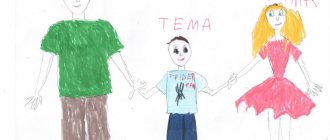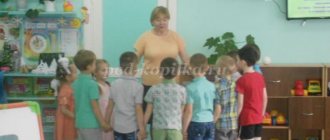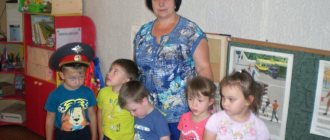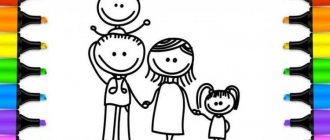Drawing in the senior group “Children doing exercises”
Valentina Podshivailova
Drawing in the senior group “Children doing exercises”
Summary of organized educational activities “Artistic Creativity”
.
Drawing in the senior group “ Children doing exercises ”
Integration: "Communication"
,
“Physical education”
,
“Music”
,
“Socialization”
Types of children's activities: productive, communicative.
Purpose: to train children in drawing a human figure in motion.
- consolidate the methods of making a sketch with a simple pencil, followed by painting with colored pencils;
- arouse interest in sports;
- develop fine motor skills;
- to form in children the desire to complete the work they start.
The best exercises and drills to help you learn!
This is general information and should not be confused with advice. Talk to a specialist in all health-related matters and ask for their advice. Children must be supervised by adults at all times. We disclaim all liability for any physical damage caused by the information on this website. For more information, please see our disclaimer and privacy policy.
The handstand is one of the most important skills in gymnastics. The straight-body handstand position is not only one of the foundations of floor exercise, but of other skills as well. Position yourself in giant handstand on bars, in front Handspring on the vault and in handsprings (front and back) on both beam and floor. So, it is important to both learn and master the perfect handstand.
We're going to share with you some exercises you can do to strengthen the muscles needed for handstands, as well as some exercises you can do at home and at the gym to learn how to do a handstand.
Click here to download the GymnasticsHQ 10-Minute Handstand Workout
Muscles Required for Handstands
You need strong arms and shoulders and a strong core to master and master the perfect handstand.
- Arms and Shoulders : You need strong arms and shoulders to support your body in a handstand. You also use your shoulder muscles to maintain balance.
- Core : You need a strong core to hold your body in a tight position.
Exercises you can do at home
We have listed some exercises that you can do at home to strengthen the muscles needed for a perfect handstand.
- Planks : You can perform plank exercises to strengthen the core muscles needed for handstands. You can do the plank on your wrists or elbows. When you are in the plank position, you need to squeeze your legs, glutes, and core. Your shoulders should be higher than your elbows and your body should be in a straight line from head to toe. While squeezing all your muscles and maintaining a straight body position, do not forget to breathe! The plank is great for working several muscle groups, but especially the core.
- Push-ups : Push-ups will help you develop the arm strength needed to hold a handstand. Get into a plank position with your body straight and your shoulders resting on your wrists. Squeeze your torso and buttocks and bend your arms. You want to focus on your body position and go as deep as you can while maintaining control of your movement. Raise your body again with your arms straight to complete the rep.
- Pull-ups : Pull-ups help strengthen your upper body, arms, and shoulders. You can do both pull-ups and barbell pull-ups to increase arm strength. For pull-ups, you hold the bar with your fingers pointing away from your body and tuck your chin over the bar. When doing a pull-up, you hold the bar with your fingers toward your body.
This is a great skill development video for learning handstands.
Handstand exercises you can do at home
You can see many of the exercises mentioned in the video above. These are exercises and parts of the handstand that you can practice at home.
Lunge : You can practice the initial lunge for handstand. Start standing with your feet together and your arms at your sides. Then, to begin the lunge, raise your arms straight above your head near your ears, place your lead leg in front of you, and bend it slightly. The back leg should be straight. Hold this position for 3 seconds (you want to squeeze your core) and then bring your legs together with your arms at your sides.
Lunge and Lever : The lunge part of the lunge and the lever are the same, but then you want your body to be in a "T" shape. To do this, with your arms extended above your head next to your ears, lift your back leg up while lowering your torso and arms. You want your body to remain straight. You want to stop with your back leg directly behind you, perpendicular to the leg you're standing on, while your torso is also perpendicular to the leg you're standing on. You want to be in a "T" shape with your body. After you press “T,” slowly return to the lunge, keeping your arms and torso in a straight line with your back leg.
Wall Spiderman: Wall Spiderman is a way to do a handstand against a wall, using the wall to both support and keep you upright.
To do this, stand near a wall that is not near anything (furniture or other objects) that you can hit. You can also do this using a wedge against the wall or using a homework mat for a handstand. Stand with your back to the wall. Place your hands on the ground and one foot on wa .
Drawing in the senior group on the topic “Children doing exercises”
Artistic and aesthetic development
– drawing (03/02/2021) Educator: Savchuk E.A.
Subject:
“Children doing exercises” Komarova, 82
Target
: master the basics of drawing the movements of the human body.
Priority educational area
: artistic and aesthetic development in the integration of educational areas: “physical development”, “speech development”.
Technologies, methods, techniques:
“Morning of joyful meetings”, the theory of the development of cognitive interest (the interest of the teacher himself, the active use of accumulated knowledge, the optimal combination of group and individual forms); theory of developmental learning (independent mental activity)
Material/literature
: album sheets, a simple pencil, colored pencils, audio recordings of songs for exercises.
Preliminary work
: conversation about a healthy lifestyle, why it is useful to do exercises; make moving people from counting sticks.
— Development of the ability to depict human figures, paying attention to the proportionality of various parts of the human body.
- the ability to express yourself in a drawing
—
Development of children's visual creativity.
—
Strengthening children's ability to place images on a sheet of paper and draw large.
- fostering a love for sports, showing that it is useful and interesting.
Set-up for the lesson:
Place your palms on your chest, where your heart is. Listen to how it beats. Feel and imagine how your palms are filled with the warmth and kindness of your heart. Now share the warmth and kindness of your heart with each other, holding hands. Smile at each other. In such a good mood, let's go to the tables.
People from fairyland love to do gymnastics and exercises. And they have many of their favorite exercises. These fabulous little people really want to get to know your favorite exercises.
- Shall we help them? But how to do this?
I think I came up with an idea, let’s draw how we do exercises, but let everyone draw their own exercise.
They bent their arms to the side, raised them up, waved,
They hid them behind their backs. Looked over your right shoulder,
Through the left one more. We sat down together,
They touched their heels, rose up on their toes, and lowered their hands down.
Independent work of children
First, sketch your drawing with a simple pencil, then start coloring with colored pencils.
(During the drawing process, the teacher provides individual assistance and monitors posture)
So we have seen what exercises each of you likes.
I really liked your drawings, you know a lot of physical exercises. Don't forget to do them every day and you will be strong, agile, fast!
Didn't find what you were looking for?
You might be interested in these courses:
How to draw a head from any angle
Assignment: Draw Loomis's head
Take a few pictures of yourself or someone else and then use them to build a head using the Loomis method. Focus on the correct up and down tilt. Be sure to take the careful measurements I mentioned in this video and keep the lines clean. Remember that each person has individual proportions that will differ from the average loom head. At this point, simply draw the average proportions. Once you get comfortable with this, you can try to capture the distinctive features of the person you are drawing.
If you're having trouble drawing a circle or oval for your head, spend a little time at the beginning of each day warming up your hand with a lot of circles and ovals.
Post your drawings to the Portrait Facebook group for feedback
Visit the Premium Portrait course to support lessons and access all portrait videos.
Drawing the head
In this first tutorial I'm going to try to summarize and simplify Andrew Loomis' approach to drawing a head . Like this.
If we take the head and remove the eyes, nose, lips and ears, we are left with 2 simple structures. A ball for the skull and a square shape for the jaw.
The skull is spherical in shape, but with flattened sides. Thus, cutting off a slice from both sides gives us a very close idea of the cranial mass.
When drawing the head, I'll start with a ball and draw an oval to represent the flat side plane. Size is important here. Make sure the ball is a perfect circle . Don't be careless. The oval is a little more difficult. The height will always be the same no matter what angle you draw the head from. This is ⅔ the height of the circle. From the center and top of the circle, divide this area into three parts and you will get the top of the oval. Do the same below.
Finding left and right turns: The width of the oval will depend on the direction in which the person is looking. Compare the size of the front plane with the size of the side plane. The upper part of the oval falls on the corner of the forehead, where the anterior plane meets the lateral plane. This area is usually rounded, so it is open to the artist's interpretation. I have found that it is usually located near the end of the eyebrow. The line on the front plane represents the eyebrow, so pay attention to the angle from one eyebrow to the other.
Definition of up and down slope: Vertical slope is indicated by the angle along the lateral plane. If the head is tilted up, the angle will be upward, and if the head is tilted down, the angle will be downward. The degree of slope determines how steep the line will be. I like to use the angle from ear to eyebrow.
Then, at the base of the vertical line, draw a curve identical to the line of the brow ridge. This represents the bottom of the nose. Drawing the same line from the top of the oval again will take you to the hairline.
The face can be divided into almost perfect thirds: chin, nose, forehead and hair.
We can use the measurements we've already found to determine where the chin should be.
Observe the overall shape of the jaw and draw the main angles, starting from the eyebrow and ending with the side plane of the head. This is usually about halfway up the oval or a little further back.
Now that we have the foundation of the head, we can finish it off by adding all the features! Don't worry, next time I will explain this step in more detail. Each function deserves its own lesson.
Let's go through this again.
- Start with a circle for the skull
- Oval for the side of the head
- Angle to show a person looking up or down. I'll go with a slight downward slope.
- Draw an identical curve to find the nose
- Double this distance to find the chin
- Attach the sponge
Now you have a 3D representation of the head, ready to show details. This approach is really good for determining the perspective of the head. A good exercise is to try to imagine the head as a simple elongated box.
The angles on the front plane of the face, such as the hairline, eyebrow line, nostrils, lips and chin, will be the same as the angles on the front plane of the frame. The angle from the eyebrow line to the ear is the same as the angle on the side plane of the box.
These angles are really important because they define the head as a three-dimensional shape in space.
This may seem overly technical with so many details to remember, but with practice it actually becomes very easy, so get out the sketchbook and practice hundreds of times from different angles! You will find that you get better much faster than you think.
Drawing the Head and Hands - Andrew Loomis
This video sums up this book. The full version is a great resource.
Like what you learned? Check out the next tutorial on How to Draw a Head from the Side!
Filed in: Basics • Portrait/Head • Video
Leave your comment
Gift certificates
Responsibility for resolving any controversial issues regarding the materials themselves and their contents is taken by the users who posted the material on the site. However, the site administration is ready to provide all possible support in resolving any issues related to the work and content of the site. If you notice that materials are being used illegally on this site, please notify the site administration using the feedback form.
All materials posted on the site were created by the authors of the site or posted by users of the site and are presented on the site for informational purposes only. Copyrights for materials belong to their legal authors. Partial or complete copying of site materials without written permission from the site administration is prohibited! The opinion of the administration may not coincide with the point of view of the authors.
Source
English Lesson Directions
Sometimes you may be asked by someone for directions.
Giving directions and asking for directions English lesson
In this lesson you will learn how to give directions to another person when they ask you how to go somewhere. and also give examples of how to ask for directions.
Important verbs and prepositions when giving directions
Ask someone
** Hint Key words are highlighted **
Questions about the route
Can you please tell me how I can get to Oxford Street?
Where is the nearest supermarket ?
How can I get to the local market ?
I'm trying to find a number to call from Downing Street .
How to get to the office ?
What's the best way to get to your home next time?
Where is Mc Donalds, please tell me?
How to show someone the way
Continue straight along until you see the hospital, then turn left.
Turn back , you've passed the turn.
Turn left when you see the roundabout.
At the end of the road turn right , my house is 67.
Cross the intersection and continue for about 1 mile.
Take the third road to the right , you will see the office on the right
Take the third road on the right , you will see a store on the left
Take the second road on the left , you will see a house on the left
Take the second road on the left and you will see the hospital straight ahead
The hospital is opposite the railway station .
Shop near the hospital .
The house is next to the local cricket ground.
The store is located between a pharmacy and KFC.
At the end of the road you will see a roundabout.
At the corner of the road you will see a red building. Just around the corner is my house, you'll have to stop quickly or you'll miss it.
At the traffic light, go straight ahead .
turn right at the intersection .
Follow signs towards Manchester.
Conversation with direction
When giving directions, it is best to use short, basic sentences in English. Speak slowly to the other person, spell the words if they don't understand, and if possible, draw a map.
Mr. Bean: - Please tell me how I get to your apartment?
Mrs. Smith: Are you going by car or by bus?
Mr. Bean: - I'm driving a car.
Mr. Bean: - Please tell me what is the easiest way to get to your apartment?
Mrs Smith: Take the M6 into Manchester and exit at junction 6
Mr. Bean: - Manchester, you can spell it
Mrs. Smith: - M a n s e t e r r
Mr Bean: Thank you
Mrs Smith: - Okay, then turn right at the roundabout and turn left. My house is on the left next to the local grocery store.
Mr. Bean: Is this the fastest way to get to your apartment?
Mrs. Smith: Yes, by car is the fastest way.
Mr. Bean: - Draw me a map, please, I don’t know the area.
Mrs. Smith: Yes.
Mr. Bean: Thank you.
And finally, some tips
Speak slowly so that the other person understands.
Speak slowly so that the other person can write down instructions while talking on the phone.
When talking to someone, use your hands to demonstrate what you mean, left, right, or straight.
Always try to use the word "please" when asking someone for directions. It's polite and people will be more likely to help you!
Lessons that may be related to instruction
English lesson on how to ask and give directions
Conversation English Lesson
Talk about direction
Directions - Asking People - Learning English
Directions left/right and around corners English lesson
Print out an English lesson on how to give directions.
Print a lesson on how to ask or give directions. Right-click on the white space and select print. You can click the printer icon just below and to the right of the Contact Us menu button at the top of the page, or you can copy and paste the desired portion of the exercise into a word document and then print it out on paper.
Dictionary and how to use dictionaries
Click the following link to open the online English dictionary - English Lesson
Easy Pace Training Forum
If you have problems with a lesson or exercise, please ask a question, we will try to help you or post your answers so others can compare









